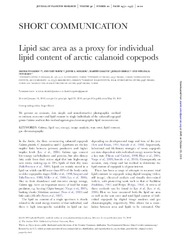Blar i forfatter "Vogedes, Daniel Ludwig"
-
All-sky camera system providing high temporal resolution annual time series of irradiance in the arctic
Johnsen, Geir; Zolich, Artur; Grant, Stephen; Bjorgum, Rune; Cohen, Jonathan H.; Mckee, David; Kopec, Tomasz Piotr; Vogedes, Daniel Ludwig; Berge, Jorgen (Journal article; Tidsskriftartikkel; Peer reviewed, 2021-07-23)The ArcLight observatory provides hourly continuous time series of light regime data (intensity, spectral composition, and photoperiod) from the Arctic, Svalbard at 79° N. Until now, no complete annual time series of biologically relevant light has been provided from the high Arctic due to insufficient sensitivity of commercial light sensors during the Polar Night. We describe a camera system providing ... -
Artificial light during the polar night disrupts Arctic fish and zooplankton behavior down to 200 m depth
Berge, Jørgen; Geoffroy, Maxime; Daase, Malin; Cottier, Finlo Robert; Priou, Pierre; Cohen, Jonathan H.; Johnsen, Geir; McKee, David; Kostakis, I; Renaud, Paul E.; Vogedes, Daniel Ludwig; Anderson, Philip J.; Last, Kim; Gauthier, Stephane (Journal article; Tidsskriftartikkel; Peer reviewed, 2020-03-05)For organisms that remain active in one of the last undisturbed and pristine dark environments on the planet—the Arctic Polar Night—the moon, stars and aurora borealis may provide important cues to guide distribution and behaviours, including predator-prey interactions. With a changing climate and increased human activities in the Arctic, such natural light sources will in many places be masked by ... -
Calanus spp. in the Arctic ecosystem - a story on predation, distribution and methodology
Vogedes, Daniel Ludwig (Doctoral thesis; Doktorgradsavhandling, 2014-11-19)The calanoid copepods of the genus Calanus (C. finmarchicus, C. glacialis and C. hyperboreus) are key elements in the Arctic ecosystem. They link primary producers (ice algae, phytoplankton) and higher trophic levels through their ability to convert low energy carbohydrates and proteins to high energy wax esters. This energy is stored in a separate and conspicuous lipid sac. This ability to store ... -
Lipid sac area as a proxy for individual lipid content of arctic calanoid copepods
Vogedes, Daniel Ludwig; Varpe, Øystein; Søreide, Janne; Graeve, M; Berge, Jørgen; Falk-Petersen, Stig (Journal article; Tidsskriftartikkel; Peer reviewed, 2010)We present an accurate, fast, simple and non-destructive photographic method to estimate wax ester and lipid content in single individuals of the calanoid copepod genus Calanus and test this method against gas-chromatographic lipid measurements. -
Pelagic food-webs in a changing Arctic: a trait-based perspective suggests a mode of resilience
Renaud, Paul Eric; Daase, Malin; Banas, Neil; Gabrielsen, Tove M.; Søreide, Janne; Varpe, Øystein; Cottier, Finlo Robert; Falk-Petersen, Stig; Halsband, Claudia; Vogedes, Daniel Ludwig; Heggland, Kristin; Berge, Jørgen (Journal article; Tidsskriftartikkel; Peer reviewed, 2018-06-27)Arctic marine ecosystems support fisheries of significant and increasing economic and nutritional value. Commercial stocks are sustained by pelagic food webs with relatively few keystone taxa mediating energy transfer to higher trophic levels, and it remains largely unknown how these taxa will be affected by changing climate and the influx of boreal taxa. <i>Calanus</i> species store large quantities ... -
Potential misidentifications of two climate indicator species of the marine arctic ecosystem: Calanus glacialis and C. finmarchicus
Gabrielsen, Tove M; Merkel, Benjamin; Søreide, Janne; Johansson-Karlsson, Emma; Bailey, Allison; Vogedes, Daniel Ludwig; Nygård, Henrik Andreas; Varpe, Øystein; Berge, Jørgen (Journal article; Tidsskriftartikkel; Peer reviewed, 2012)Calanoid copepods of the genus Calanus represent an important, nutrient-rich food source for a multitude of Arctic marine organisms. Although morphologically very similar, their life histories and ecological roles differ. Because the distribution of Calanus glacialis and C. finmarchicus corresponds to Arctic and Atlantic water masses, respectively, they are regularly used as climate indicators. A ... -
Recruitment of benthic invertebrates in high Arctic fjords: Relation to temperature, depth, and season
Meyer, Kirstin S.; Sweetman, Andrew K; Kuklinski, Piotr; Leopold, Peter; Vogedes, Daniel Ludwig; Berge, Jørgen; Griffith, Colin; Young, Craig M; Renaud, Paul (Journal article; Tidsskriftartikkel; Peer reviewed, 2017-05-30)In the high Arctic, recruitment of hard-bottom benthic organisms has been studied at single locations, but little is known about how it varies spatially or temporally, or how it is influenced by abiotic factors. In this study, settlement plates were simultaneously deployed at five locations in three Svalbard (Norway) fjords at depths ranging from 7 m to 215 m. Recruitment was significantly different ... -
Variability in Calanus spp. abundance on fine- to mesoscales in an Arctic fjord: implications for little auk feeding
Vogedes, Daniel Ludwig; Eiane, Ketil; Båtnes, Anna Solvang; Berge, Jørgen (Journal article; Tidsskriftartikkel; Peer reviewed, 2014)


 English
English norsk
norsk






